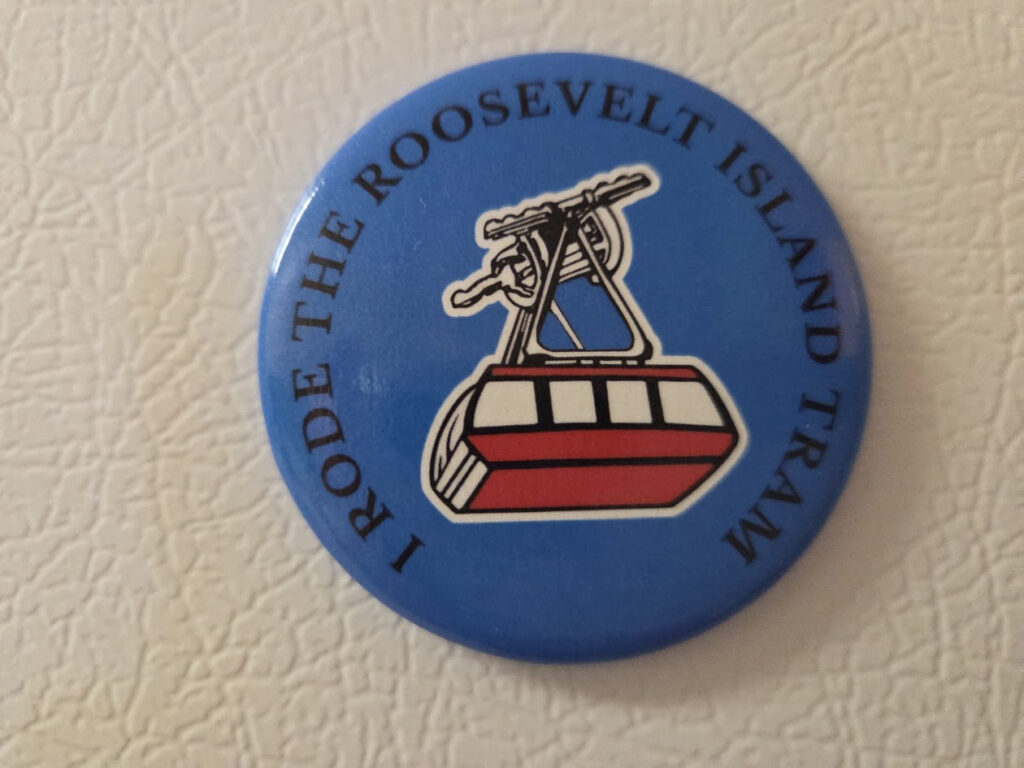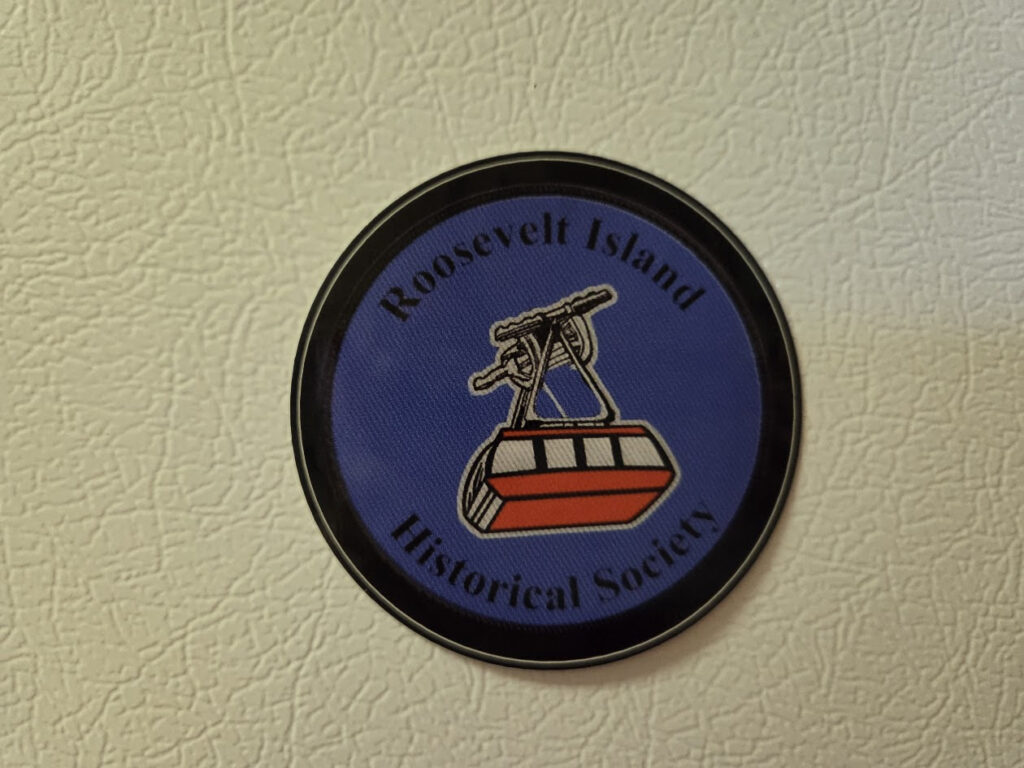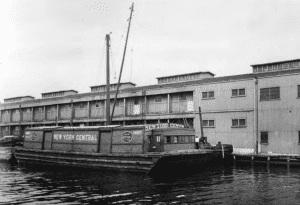Thursday, May 22, 2025 – THESE WERE THE PREDECESSORS OF THOSE WE SEE ON THE EAST RIVER


NEW MAGNET & STICKER
ON SALE AT THE R.I.H.S. KIOSK
$5- EACH


NEW YORK WATERCRAFT:
WORKING WITH FREIGHT
NEW YORK ALMANACK
Thursday, May 22, 2025
ISSUE #1455
New York Watercraft: Working With Freight
May 15, 2025 by Guest Contributor

Covered barges were once heavily employed in the New York port areas to lighter (i.e., load, transport, and offload) various non-bulk, perishable cargoes from and to ship or shore.
By the mid-nineteenth century, covered barges with boat-shaped hulls were present in New York State ports, including Plattsburgh, Whitehall, Buffalo, Troy, Albany and other Hudson River and New York Bay ports.
There is uncertainty regarding the evolution covered barges, but similar to other barge types by the late nineteenth century the covered lighter barge was predominantly scow hulled (flat-bottomed, with raking ends. Using either a stanchion or bulkhead hull system, the barge featured a one-story structure or shed covering most of the deck, with all cargo carried on deck.
Often barn sided, two large sliding doors opened port and starboard when cargo was handled over the gangway. A hatch at the margin of the roof allowed for vertical hoisting of goods when possible.
Vents positioned at each end of the shed (attached to large ice bins) provided refrigeration for perishable items. Filled with ice through hatches in the roof, the vents circulated cool air top and bottom. When necessary, a stove, installed in the center of the shed, circulated warm, dry air.

Some companies preferred centered penthouse cabins over the usual stern counterpart. The higher elevation permitted a 360-degree view of surroundings and, perhaps more importantly, wasted no cargo space.
Some covered barges featured hoisting gear. A single mast with booms rose above the center of the deck house. Part of the rooftop cabin accommodated a steam-, or later, oil-or gasoline-powered winch.
Many captains lived on board with their families; the size of the cabin varied from a shed to a family’s permanent residence. Besides providing extra security, night-time operations (towing, moving, loading, etc.) required the captain’s presence.
Of 208 un-rigged boats owned by one company in 1918, 89 housed families with children ages one through 10, 71 had captains and their wives, and 48 had captains living alone on the boat.
Living conditions on board no doubt varied, but general descriptions mention crowded, damp, foul-smelling rooms. “The general impression given is that of dirt and disorder,” one observer reported in 1918.
Some companies tried to accommodate their employees if possible, providing stoves, furniture, etc., while others provided nothing at all. One company (200 un-rigged boats) provided nothing for its employees.
As a vessel type, the wooden-hulled, covered barge is well documented; numerous plans exist, several examples along waterfronts have been extensively recorded.
Replaced in time by steel covered barges, the last wooden-hulled covered barges were built in the 1950s.
A barge variation, the A-frame crane barge was most likely adapted from mid-to late nineteenth-century shore-based lifting equipment such as the stiff leg. These towed cranes were employed in ship salvage, dock and pier construction, and repair and cargo transfers. The cranes and hoisting machinery are situated atop scow hulls.

Builders also developed several types of scows capable of dumping garbage and dredge spoil at sea, or depositing breakwater/shoreline extension fill. Of the types that were developed, including the hopper barge, the side-dumping scow, and the hinged scow, the hopper barge was the most common, possibly due to its functional design.
Plans of a 1927 six-pocket (hopper) dump scow (a hopper barge) show that instead of a raked bow and stern seen on a typical scow, the hopper barge has curved ends forming one-quarter or a circle from the keel to deck.
Another dump scow type was the side-dump scow. Similar in hull configuration to the basic scow, it had bulkheads similar to those of a rock scow. It differed from both in that its deck was not level, but rather sloped downward 45 degrees on either side of the longitudinal centerline between the end bulkheads.
This sloped deck was divided into sections by additional transverse bulkheads, with the “cargo” held in place and later released by bay doors at the base of the sloped deck.
The Derrick or Stick Lighter
Open-decked derrick lighters were employed in New York port areas to lighter (i.e., load, transport, and offload) various cargoes from and to ship or shore. Early stick lighters, as they became popularly known, likely because of prominent timber masts and cargo booms, had boat-shaped hulls, pointed bows, and elliptical sterns.

There is uncertainty regarding an association between this configuration and lighters or sailing craft, but by the late nineteenth century the derrick lighters were predominantly scow hulled.
We do know that the advent of the steam tow was a significant impetus in the use, acceptance, and profusion of this vessel type, the combination of the steam tow and barges making the sailing lighter uneconomical and thus contributing to its demise.
The employment of the scow hull for this vessel type, as seen on so many of the later barges and work platforms, may have been associated with the economic practicality in building this type of hull (i.e., less boat-building craftsmanship, fewer curved timbers), as well as its proven functional aspects.
The derrick lighter had a single sturdy timber mast stepped in one of two locations, either in the center of the deck or at the stern just in front of a small crew cabin. If the mast rested aft, only one cargo boom pointed forward. In the former case, there would be two cargo booms, one pointing forward and one pointing aft.
The cargo booms were usually rigged like a sailing ship’s fixed gaff in the central mast configuration. Fitted with wooden jaws to allow lateral swinging, and held at a constant angle by fixed wire topping lifts, they would be positioned about three-quarters of the way up the mast.
The masts measured around 50 feet in height. In the central mast arrangement, the boat had two lighter masts at the bow and stern just forward of the cabin. Three masts around 20 feet high had sheaves mounted near their tops for lines used in hoisting the ends of a tarpaulin used in the protection of cargo.

In 1985, Norman Brouwer recorded the intact derrick lighter L.V.R.R. No. 462, grounded at Edgewater, New Jersey. The boat, built at Mariner’s Harbor, Staten Island in 1926, measured 104.5 feet in length, 32 feet in breadth, 7.8 feet depth of hull.
A large winch house stood on deck aft, with mast and boom positioned directly in front of the house. The largest openings in the deck, small rectangular hatches, provided access and ventilation.
A system of longitudinal bulkheads and timber pillars linked by crossed diagonal timber braces supported the deck. The derrick barge had more diagonal braces at the side rather than natural knees. A continuous row of windows spanned the front of the deck house.
The cabin measured 6 feet 2 inches across the windows, 14 feet 9 inches at the side of the deckhouse ande featured tongue-and-groove details.
Later derrick lighters were fitted with steel A-frames and steel booms in place of their wooden counterparts. The wooden scow hull was eventually replaced with a steel barge hull, retaining its steel A-fame.
NEW STICKER SHEETS
BY JESSICA
NOW AVAILABLE AT THE
RIHS KIOSK ($5-)

WANTED
FOR OUR 50TH ANNIVERSARY CELEBRATION
“KEEPING HISTORY ALIVE”
PHOTOS OF THE ISLAND, THE PEOPLE, PLACES, EVENTS THAT MADE OUR COMMUNITY FROM 1975 TO TODAY.
SEND US YOUR PHOTOGRAPHS OF LIFE ON THE ISLAND FOR OUR EXHIBIT DURING OUR CELEBRATION STARTING JUNE 7.
CONTACT JBIRD134@AOL.COM FOR DETAILS.
CREDITS
NEW YORK ALMANACK
All image are copyrighted (c) Roosevelt Island Historical Society unless otherwise indicated
THIS PUBLICATION FUNDED BY DISCRETIONARY FUNDS FROM CITY COUNCIL MEMBER JULIE MENIN & ROOSEVELT ISLAND OPERATING CORPORATION PUBLIC PURPOSE FUNDS.


Copyright © 2025 Roosevelt Island Historical Society, All rights reserved.Our mailing address is:
rooseveltislandhistory@gmail.com

Leave a comment